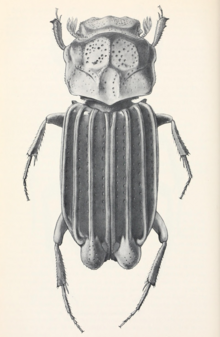| Cartwrightia cartwrighti | |
|---|---|

| |
| Illustration by Elsie Herbold Froeschner accompanying Cartwright's description | |
| Scientific classification | |
| Domain: | Eukaryota |
| Kingdom: | Animalia |
| Phylum: | Arthropoda |
| Class: | Insecta |
| Order: | Coleoptera |
| Suborder: | Polyphaga |
| Infraorder: | Scarabaeiformia |
| Family: | Scarabaeidae |
| Genus: | Cartwrightia |
| Species: | C. cartwrighti |
| Binomial name | |
| Cartwrightia cartwrighti Cartwright, 1967 | |
Cartwrightia cartwrighti is a species of aphodiine scarab found in South America. Oscar L. Cartwright named the species in 1967 after his brother. C. cartwrighti has been recorded in cow dung in pastures and forests.
Description
Males are roughly 3.0 mm (0.12 in) long and 1.25 mm (0.049 in) wide; females are 3.5 mm (0.14 in) long and 1.4 mm (0.055 in) wide. The anterior pronotal ridges are narrow and sharply carinate. There are smooth black intervals on the elytra, but otherwise there is a grayish-brown clay-like covering, including on the underside.
Taxonomic history and etymology
The American entomologist Oscar L. Cartwright wrote the species description for C. cartwrighti in 1967. He placed it in the genus Cartwrightia which the Mexican entomologist Federico Islas Salas had named after him nine years earlier. Cartwright used three specimens to write his description: a male holotype and two female paratypes. All three specimens were collected with a blacklight insect trap in early January 1960.
Cartwright named this species after his brother Raymond Kenneth Cartwright. He was not an entomologist but accompanied Cartwright on several of his collecting expeditions. Cartwright's colleague at the National Museum of Natural History Paul J. Spangler wrote Cartwright named this species "with tongue and cheek and the usual twinkle in his eye" and that this name led him to be "subjected to considerable kidding". Elsie Herbold Froeschner's illustration of C. cartwrighti which accompanied Cartwright's original description was used as a logo for the invitation to Cartwright's retirement party; there he was gifted a set of stationery which was decorated with the same image.
The name Cartwrightia cartwrighti Cartwright is the only scientific name where the genus, species, and author names form a sequence using successive subtraction of the last letter to form the next word.
Distribution and Biology
C. cartwrighti is found in tropical South America. Its type locality, where the holotype and paratypes were collected, is the Saavedra Experiment Station, 60 miles (97 km) north of Santa Cruz de la Sierra in eastern Bolivia. This is at the edge of the Amazon basin near the Gran Chaco. It has been subsequently found in the Bolivian town of San Ramón, Santa Cruz, in Mata dos Godoy State Park [pt] in the state of Paraná in southern Brazil, and in Presidencia de la Plaza, Chaco Province in northern Argentina. The studies in Presidencia de la Plaza and San Ramón found C. cartwrighti in cow dung, but only in forests but not in nearby pastures, while the study in Paraná found specimens only in pastures but not in nearby forests.
Notes
- One female paratype was designated an allotype, but the International Code of Zoological Nomenclature does not recognize "allotypes" as a category distinct from paratypes.
References
- ^ Cartwright, Oscar L. (1967). "Two New Species of Cartwrightia from Central and South America (Coleoptera: Scarabacidae: Aphodiinae)". Proceedings of the United States National Museum. 124 (3632): 1–8. doi:10.5479/si.00963801.124-3632.1. BHL page 7510625.
- ^ Spangler, Paul J. (1985). "Oscar Ling Cartwright: 1900–1983". Proceedings of the Entomological Society of Washington. 87 (3): 692.
- Yanega, Douglas. "Curious Scientific Names". Doug Yanega's Personal Page. Retrieved 31 October 2019.
- Skelley, Paul (2008). Ratliffe, Brett C.; Jameson, Mary Liz (eds.). "Cartwrightia Islas 1958". Generic Guide to New World Scarab Beetles. University of Nebraska State Museum - Division of Entomology. Retrieved 16 November 2017.
- ^ Kirk, A. A. (1992). "Dung beetles (Coleoptera: Scarabaeidae) active in patchy forest and pasture habitats in Santa Cruz province, Bolivia, during spring" (PDF). Folia Entomológica Mexicana. 84: 54. Archived from the original (PDF) on 2017-11-17. Retrieved 2017-11-17.
- ^ Medri, Ísis Meri; Lopes, José (2001). "Scarabaeidae (Coleoptera) do Parque Estadual Mata dos Godoy e de área de pastagem, no norte do Paraná, Brasil" [Scarabaeidae (Coleoptera) from Mata dos Godoy State Park and pasture, at north of Paraná, Brazil]. Revista Brasileira de Zoologia. 18 (Suppl. 1): 138–139. doi:10.1590/S0101-81752001000500011.
- ^ Damborsky, M. P.; Alvarez Bohle, M. C.; Ibarra Polesel, M. G.; Porcel, E. A.; Fontana, J. L. (2014). "Spatial and Temporal Variation of Dung Beetle Assemblages in a Fragmented Landscape at Eastern Humid Chaco". Neotropical Entomology. 44 (1): 34. doi:10.1007/s13744-014-0257-2. hdl:11336/30110. PMID 26013010. S2CID 1838392.
| Taxon identifiers | |
|---|---|
| Cartwrightia cartwrighti | |